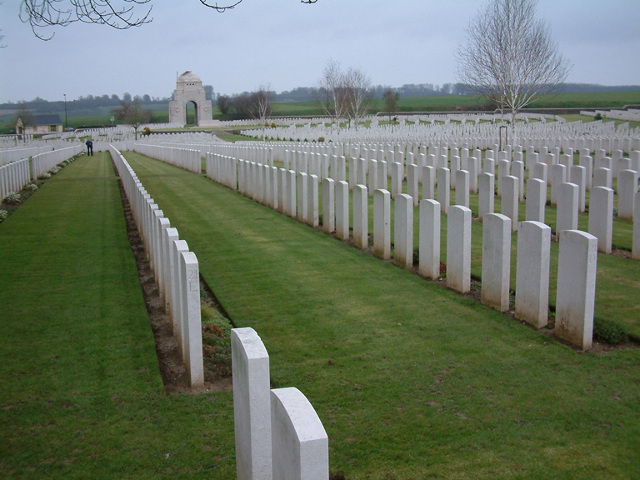![]()
WORLD WAR I
Bingham War Memorial
Historical Information - Cabaret Rouge British Cemetery, Souchez
Caberet Rouge was a small, red-bricked, red-tiled café that stood close to this site in the early days of the First World War. The café was destroyed by shellfire in March 1915 but it gave its unusual name to this sector and to a communication trench that led troops up the front-line. Commonwealth soldiers began burying their fallen comrades here in March 1916. The cemetery was used mostly by the 47th (London) Division and the Canadian Corps until August 1917 and by different fighting units until September 1918. It was greatly enlarged in the years after the war when as many as 7,000 graves were concentrated here from over 100 other cemeteries in the area. For much of the twentieth century, Cabaret Rouge served as one of a small number of ‘open cemeteries’ at which the remains of fallen servicemen newly discovered in the region were buried. Today the cemetery contains over 7,650 burials of the First World War, over half of which remain unidentified.
The Canadian Connection
Many different Commonwealth units served in this sector during the war and the cemetery contains the graves of British, Irish, Australian, New Zealand, Indian and South African soldiers. It is also the final resting place of over 70 officers of the Royal Flying Corps and Royal Air Force. Cabaret Rouge has a particularly close connection with the Canadian Infantry, however, as hundreds of Canadians who were killed at the Battle of Vimy Ridge in April 1917 were ultimately laid to rest here.
The cemetery and shelter buildings were designed by former Canadian Army officer
Frank Higginson. Higginson worked as an architect for the Commonwealth War Graves
Commission in the 1920s and later acted as Secretary to the Commission.
In May 2000 the remains of an unknown Canadian soldier were taken from this
cemetery and buried in a special tomb at the foot of the National War Memorial
in Ottowa, Canada. A focal point for remembrance, he represents more than 116,000
Canadians who lost their lives during the First World War. A headstone in plot
8, Row E, Grave 7 marks his original grave.
The Importance of Vimy Ridge
German forces seized the village of Souchez and the surrounding countryside as they advanced through Northern France in 1914. German artillery units were able to control this sector of the front from two ridges which flanked the village – Vimy Ridge to the east, and Notre Dame de Lorette to the west. After 12 months of bitter fighting, the French forces captured the high ground at Lorette in the autumn of 1915. When the French handed this part of the line to the Commonwealth forces in March 1916, Vimy Ridge was still in German hands.
Vimy Ridge was the key to the German defensive system in this sector. It protected
an area of occupied France in which coal mines and factories were in full production
for the German war effort and the fortified vantage points on the ridge dominated
the surrounding battlefields.
The Battle of Vimy Ridge formed part of the opening phase of the British-led
Battle of Arras which began on 9 April 1917. The Canadian forces managed to
capture most of the German positions on the ridge on the first day of the attack
and by 12 April they had occupied the village of Thélus and pushed the
Germans back to the Oppy-Méricourt line. By taking the ridge the Canadians
achieved a major tactical success, but in just four days of fighting they suffered
over 10,000 casualties, 3,500 of whom were killed. The battle was the first
action in which all four divisions of the Canadian Corps fought together and
had a major impact on Canadian national identity.
From Commonwealth War Graves Commission web site


